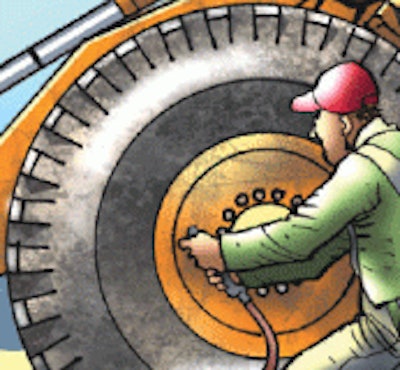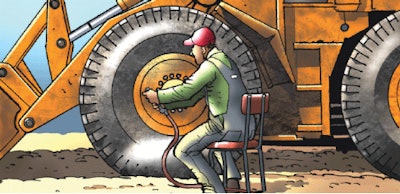

The accident
A laborer was inflating a flat tire mounted to a multi-piece rim on a wheel loader. He was seated on a chair about 12 inches from the tire’s sidewall, using an air chuck attached to an air line and a compressor. Increased air pressure caused the tire to explode, knocking the worker approximately 6 feet backwards. An employee who heard the explosion called emergency medical services personnel, who responded and pronounced him dead on the scene from head trauma.
The bottom line
A post-accident investigation determined the rim’s lock ring had become partially unseated when the tire fully deflated. The air compressor the worker was using had a faulty pressure gauge, making him unable to measure the tire’s increasing pressure. The pressure caused the tire to exploded, which caused the locking ring and tire to dislodge from the rim. No defects were found in the wheel following an inspection.
Accidents such as this are almost completely preventable, as long as you follow the correct steps. If you’re assigned to inflate a tire, remember these guidelines:
• If the tire has a multi-piece rim, don’t inflate it while the wheel is mounted on the equipment, particularly if the tire has less than 80 percent of the recommended pressure. Take the tire off the machine, disassemble and inspect the rim, then reassemble and inflate the tire.
• Avoid positioning yourself in front of, over, or otherwise in the trajectory of the tire. If the tire is simply under-inflated, and has more than 80 percent of the recommended pressure, it can be inflated while on the equipment. However, OSHA requires the tire be inflated from a distance – standing behind the tire tread while using a long air line with a clip-on chuck, and an in-line valve with a pressure gauge.
• After inflation, inspect the tire and wheel components to make sure they are properly seated and locked. Never try to reposition side and lock rings by forcing or hammering the components while the tire is pressurized. Rim components that show damage such as bends, cracks or breaks should never be welded or reworked.
Information for this Safety Watch came from an accident report, OSHA 29CFR 1910.177 and the Center for Disease Control’s NIOSH Fatality Assessment and Control Evaluation program. It is meant for general information only.












